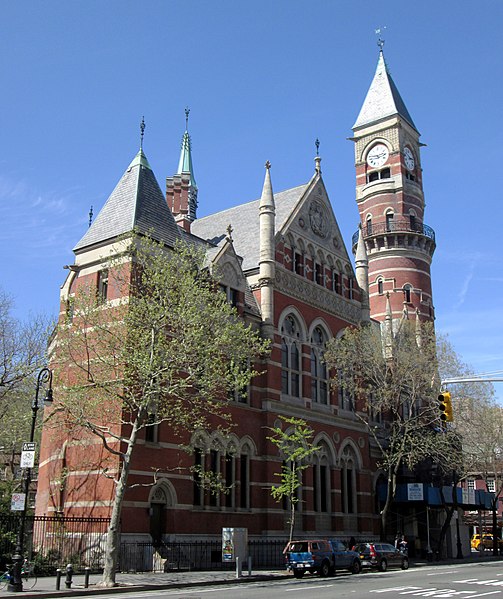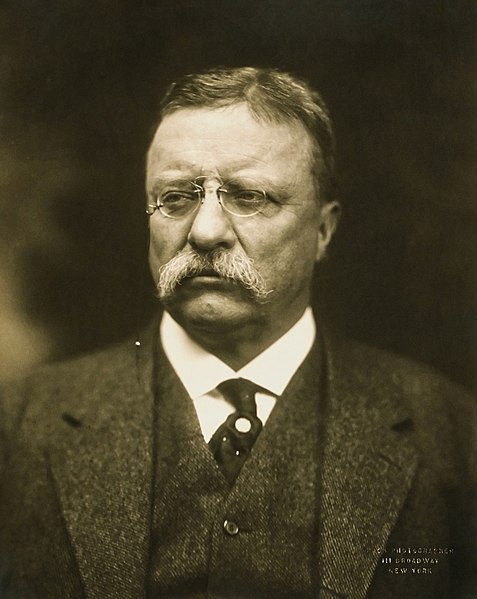 |
| Beyond My Ken |
Before the library, there was a courthouse, and before the
courthouse, a market. The produce market, named for our third
president, opened on the site in 1833, alongside a wooden fire tower and a
small jail, and continued for many years.
In 1845 the city divided the expanding city into three police districts,
and the Second District police court opened at the site of the market. Then, in the 1870s, the ever expanding city
decided to tear down the market sheds and the fire tower (some sources say it
had, alas, burned down) to build a new courthouse, the Victorian Gothic
building of today, which opened in 1877.
Modeled in part on King Ludwig II of Bavaria’s fairy-tale
castle Neuschwanstein, the asymmetrical
structure’s red-brick walls with limestone trim rise impressively with pointed
windows, steeply sloping roofs, gables, and pinnacles. Dominating the structure is a 100-foot tower with
clocks on all four sides and ringed by a balcony where fire watchers could
oversee the area and ring alarms with a bell that still hangs in the tower
today. It is a strikingly picturesque
monument and was recognized as such in its own time, though few passersby today
bother to stop, gaze up, and admire it.


Inside, the second floor that now houses an adult reading
room was a civil court, while the ground floor had a police court where the
children’s room now is, and the basement, now a reference room, served as a holding
pen for prisoners on their way to jail or a trial. Built at the same time was an adjacent prison
on West 10th Street, needed to relieve crowding in the gloomy downtown
prison known as the Tombs.
And now for the notorious trio. On February 11, 1878, bystanders on Sixth
Avenue were astonished to see a fashionable carriage with a coachman in livery
arrive at the courthouse. From it emerged
a well-dressed woman who turned out to be Ann Lohman, alias Madame Restell, the
most notorious – and successful – abortionist in the city, who had pursued her
calling for decades and shocked citizens by parading about in her carriage and
expensive millinery, and building a palatial brownstone mansion on Fifth Avenue,
symbols of her ill-gotten wealth.
Accompanying her was Anthony Comstock, secretary and agent of the New York
Society for the Suppression of Vice, who had just arrested her in her office in
the basement of her Fifth Avenue residence.
Entering the building, she was arraigned before a justice in the
ground-floor police court for having sold articles to produce abortion and
prevent conception. The courtroom was
thronged with journalists, for Comstock had alerted them in advance, to make
sure the arrest would be blazoned in the press on the following day. When the presiding justice refused to accept
Madame’s government bonds as bail, insisting on real estate instead, and no one
could be found to provide it, the prisoner was remanded to the Tombs, and so
began an ordeal that would end only with her suicide on the eve of her trial. (The full story is told in my biography The Wickedest Woman in New York: Madame Restell the Abortionist, which, alas, is out of print, but occasionally available secondhand, usually at an exorbitant price.)
As for the other two, according to information provided by
the library, both Harry Thaw and Mae West were tried in the Jefferson Market
Courthouse, but such was not the case. Harry
Thaw, a Pittsburgh millionaire and man about town, had long been obsessed with
the fact that his wife, Evelyn Nesbit, had once been Stanford White’s
mistress. After he shot and killed White
at the roof garden theater of Madison Square Garden on the evening of June 25,
1906, he was arrested, taken to a station house, and confined in the
Tombs. On the following day he appeared
briefly before a magistrate at the Jefferson Market courthouse and was then
returned to the Tombs. He was tried the
following year in the Supreme Court Criminal Division on Centre Street, but the
jury deadlocked. In a second trial in
1908 he was found not guilty by reason of insanity and committed to the State
Asylum for the Criminally Insane at Mattawan, New York. He escaped from there to Canada in 1913, was
brought back, then obtained a new trial that found him not guilty and no longer
insane, so that he went scot free.
On the night of February 9, 1927, the police raided Daley’s
Theater on 63rd street, where, in spite of disastrous reviews, a
risqué play entitled Sex was running;
starring in it under the name Janet Mast was Mae West, who had written,
produced, and directed it. The entire
cast of 22 were arrested on a morals charge and taken first to the local
station house and then to the Men’s Night Court on East 57th Street,
where the magistrate set Mae’s bail at $1,000.
Unable to raise the sum in the middle of the night, she spent that night
in the Jefferson Market Prison. Indicted
by a grand jury for corrupting the morals of youth (the same charge leveled
against Socrates in ancient Athens), she was tried in the Court of General
Sessions on Centre Street, found guilty, and sentenced to ten days in a
workhouse or a fine of $500. Given a
choice, she chose the workhouse for the publicity it would get, and was sent to
Welfare (now Roosevelt) Island, where she arrived festooned with white roses, allegedly
dined with the warden and his wife, and told reporters that she wore her silk
undies while serving time, and not the scratchy “burlap” that other girls had
to wear. Getting two days off for good
behavior (“the first time I ever got anything for good behavior”), she came
away a celebrity, getting $1,000 from Liberty
magazine for an exit interview.
In 1928 her play The
Pleasure Man was raided after a single performance, and she and the entire cast of 56 were arrested, but this trial ended
in a hung jury and no retrial followed. She
then revived Sex and toured the
Midwest – amazingly, without incident -- and in 1932 left for Hollywood and nationwide
fame.
To get back to the library building, it ceased to be used as
a courthouse in 1945 and was occupied by various city agencies until 1958, when
the last of them departed, leaving the Victorian Gothic masterpiece to the pigeons
and rats. Seen by many as an outdated
Victorian eyesore – “that ugly old pile” – when sleek modernity devoid of
ornament was “in,” it was tentatively slated for demolition, to be replaced by
an apartment building, but community preservationists led by Margot Gayle launched
a campaign to preserve it. Volunteers on
Village streets urged passersby to sign petitions to save the building, and my
partner Bob recalls signing one. The old
courthouse building wasn’t ugly, they argued, it was picturesque and charming;
far from being an outdated relic, it was a part of the city’s rich cultural
history and, as such, to be treasured. In
1961 Mayor Robert Wagner announced that the building would indeed be converted
into a library. Construction began in
1965, and the Jefferson Market Library opened in 1967. One of the first visitors was poet Marianne
Moore, a Village resident, who highly approved of the renovation, an opinion
that I heartily share.
And in 1996, again with the help of preservationists, the
tower fire bell, “Ol’ Jeff,” regained its voice after many years of
silence. At a subsequent community board
meeting, some neighborhood residents complained that it droned like a death
knell, but many thought it melodious. So
as not to disturb the neighbors’ sleep, it was then adjusted to strike the
hours only from 9 a.m. to 10 p.m. As for
the clocks on the tower, I have yet to check out whether or not they tell the
right time.
In 1929 the market and prison adjacent to the courthouse
were torn down, to be replaced by the Women’s House of Detention, but that’s
another story, and a grim one.
A golden throne at the Guggenheim: The ultimate in participatory art has been
achieved at the Guggenheim Museum. After
a long delay occasioned by the tricky molding and welding involved in its
making in Florence, Italian artist Maurizio Cattelan’s masterpiece, a fully
functional solid 18-karat gold toilet has been installed on the 5th-floor
ramp of the museum and is open for business indefinitely. Mr. Cattelan hopes that his chef-d’oeuvre
will not be seen as a joke, since it lets museumgoers experience a ravishingly
beautiful objet d’art on the most intimate terms. (The cost of the masterpiece, underwritten by
private donors, has not been revealed.)
Invited by the artist to make use of it, a New York Times (male) journalist
performed a number 1 and announced that it looks its best when in use, especially when
flushed. Though I don’t plan to rush to
the Guggenheim for a golden adventure, I am firmly of the opinion that the real
experience would be a #2, even if it meant foregoing the visual aspect of the
interaction. The masterpiece’s
name? “America.” Go figure.
* * * * * *
My poems: For five acceptable poems, click here and scroll down. To avoid five terrible poems, don't click here. For my poem "The Other," inspired by the Orlando massacre, click here.
My books: No Place for Normal: New York / Stories from the Most Exciting City in the World, my selection of posts from this blog, has received these awards: the Tenth Annual National Indie Excellence Award for Regional Non-Fiction; first place in the Travel category of the 2015-2016 Reader Views Literary Awards; and Honorable Mention in the Culture category of the Eric Hoffer Book Awards for 2016. For the Reader Views review by Sheri Hoyte, go here. As always, the book is available from Amazon and Barnes & Noble.
 |
The Pleasuring of Men (Gival Press, 2011), my historical novel about a young male prostitute in the late 1860s in New York who falls in love with his most difficult client, is likewise available from Amazon and Barnes & Noble.

Coming soon:
The Morgan Library, and how an American banker became a prince of the
Renaissance. (Yes, I’m back to old J.P.,
but bear with me; visiting his library unleashed a few new insights.)
© 2016 Clifford Browder

